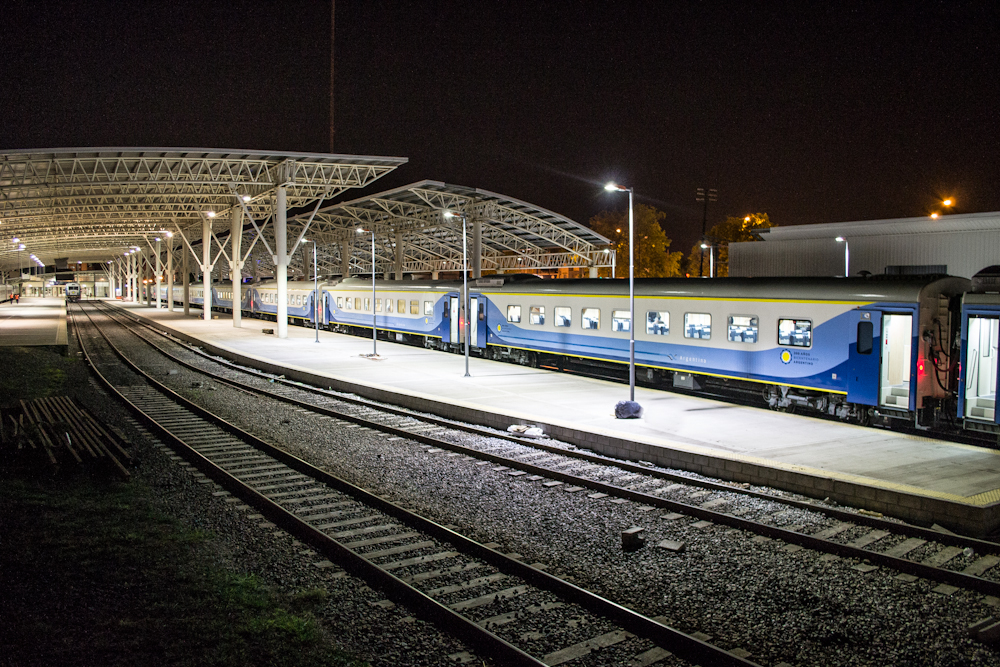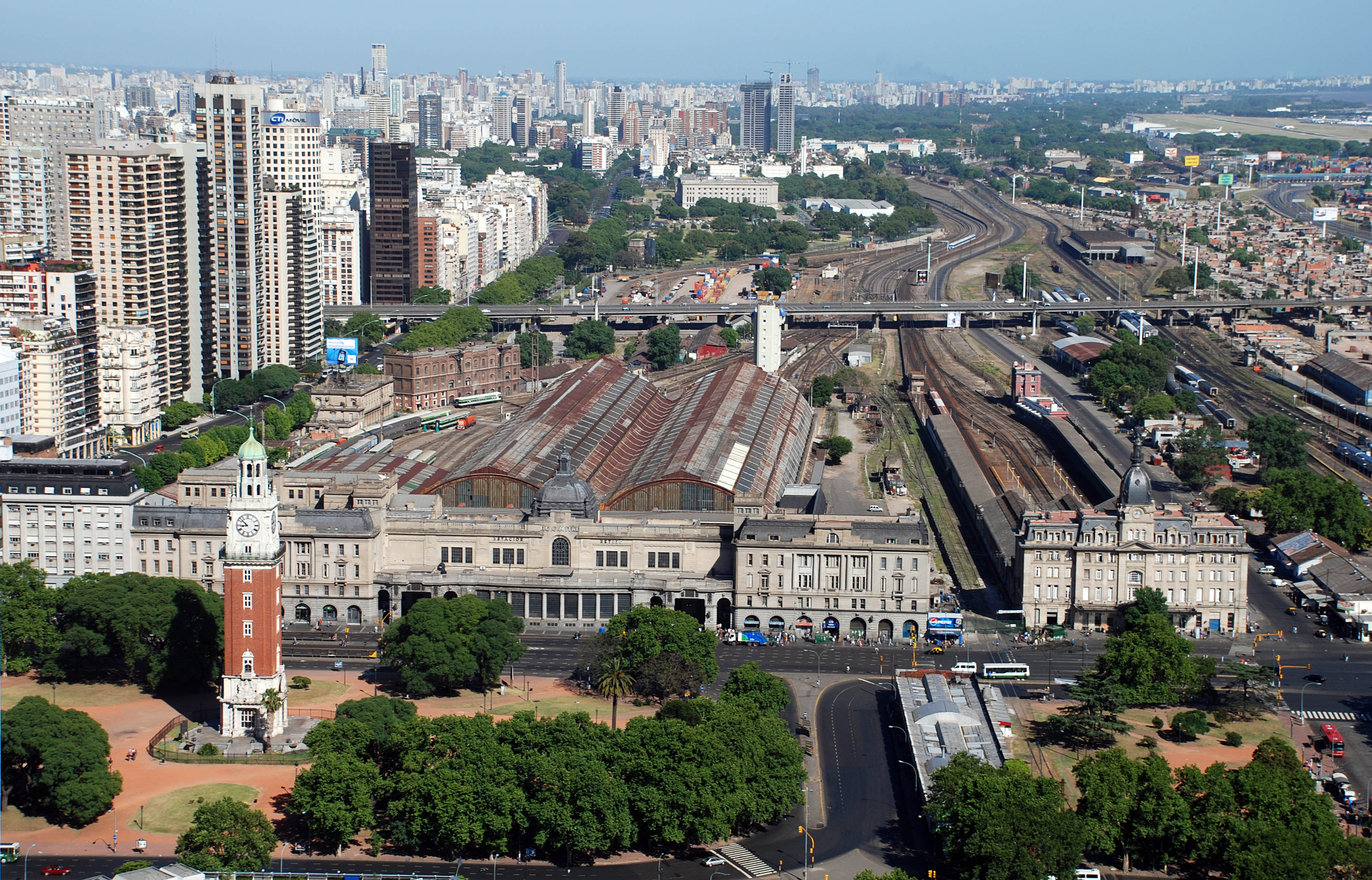|
CNR CKD8G
The CNR CKD8 is a diesel-electric transmission, diesel-electric locomotive manufactured by China CNR, China CNR Corporation from 2013 onwards for use in Argentina by state-owned Operadora Ferroviaria Sociedad del Estado, Trenes Argentinos, a subsidiary of Ferrocarriles Argentinos (2015), Ferrocarriles Argentinos S.E. The CKD8G variant is used primarily on the General Roca Railway, Roca and Sarmiento Railway, Sarmiento railways, while the faster CKD8H is used on the General San Martín Railway, San Martín and General Mitre Railway, Mitre railways. Technical specifications The locomotive has one conductor's cabin on each end, connected by an internal corridor. Its total weight is 120 tonnes with a maximum weight per axle of 20 tonnes. The four stroke 16V 4000R43 engine is manufactured by MTU Friedrichshafen and generates 2200 kW at 1800 RPM. The locomotives are divided into two sub-models, the CKD8G and the CKD8H with the latter having a higher maximum speed and tractive forc ... [...More Info...] [...Related Items...] OR: [Wikipedia] [Google] [Baidu] |
Operadora Ferroviaria Sociedad Del Estado
Operadora Ferroviaria Sociedad del Estado (abbreviated SOFSE; trading name: Trenes Argentinos Operaciones) is an Argentine state-owned company created in 2008 to operate passenger services in Argentina. It is a subsidiary of the Ferrocarriles Argentinos holding company. Since March 2015 SOFSE has run the Buenos Aires commuter rail services Mitre, San Martín, Roca and Belgrano Sur lines previously operated by private companies. History Background After the Railway privatisation in Argentina at the beginning of the 1990s the railway assets that had not given in concession were taken over by Ferrocarriles Argentinos before being dissolved. From 1996 to 2000 those assets were administered by "Ente Nacional de Administración de Bienes Ferroviarios" (ENABIEF) created through a National Decree promulgated by the Presidency of Argentina. On June 1, 2000, ENABIEF merged to Dirección Nacional de Bienes del Estado. From then on, the "Organismo Nacional de Administración de Bienes ... [...More Info...] [...Related Items...] OR: [Wikipedia] [Google] [Baidu] |
Dynamic Braking
Dynamic braking is the use of an electric traction motor as a generator when slowing a vehicle such as an electric or diesel-electric locomotive. It is termed " rheostatic" if the generated electrical power is dissipated as heat in brake grid resistors, and " regenerative" if the power is returned to the supply line. Dynamic braking reduces wear on friction-based braking components, and regeneration lowers net energy consumption. Dynamic braking may also be used on railcars with multiple units, light rail vehicles, electric trams, trolleybuses, and electric and hybrid electric automobiles. Principle of operation Converting electrical energy to the mechanical energy of a rotating shaft (electric motor) is the inverse of converting the mechanical energy of a rotating shaft to electrical energy (electric generator). Both are accomplished through the interactions of armature windings with a (relatively) moving external magnetic field, with the armature connected to an electrical ... [...More Info...] [...Related Items...] OR: [Wikipedia] [Google] [Baidu] |
Buenos Aires Underground 200 Series
The 200 Series is a set of underground cars manufactured by China CNR Corporation and CITIC Construction for use on Line A of the Buenos Aires Underground in Argentina. The cars replace the 100-year-old La Brugeoise cars which operated on the line up until 2013. The Buenos Aires Underground ordered 45 of these units, followed by a further 105 which have been put into service on the line. Background and overview Since the opening of Line A in 1913, it had used the same La Brugeoise et Nicaise et Delcuve rolling stock (along with a small number of UEC Preston cars at one point). Over the years, numerous attempts were made to replace the rolling stock on the line, though this proved challenging due to its tight curves and use of 1100 volts current instead of the 1500 volts used on the rest of the network. One such attempt was the Alstom Metropolis cars purchased at the turn of the 21st century, however these ultimately ended up serving on Line D. Before then, an attempt at cr ... [...More Info...] [...Related Items...] OR: [Wikipedia] [Google] [Baidu] |
CSR SDD7
The CSR SDD7 is a 2,249 hp diesel-electric transmission, diesel-electric locomotive manufactured by CSR Corporation Limited from 2013 onwards for use in Argentina by Operadora Ferroviaria Sociedad del Estado, Trenes Argentinos, a subsidiary of Ferrocarriles Argentinos (2015), Ferrocarriles Argentinos S.E. On the San Martín Line in Buenos Aires Province, 24 of these locomotives are used, making up the entire rolling stock of the commuter rail line. Technical specifications The locomotive has one conductor's cabin on each end, connected by an internal corridor. Its total weight is 114 tonnes with a maximum weight per axle of 19 tonnes. The 3516B engine is manufactured by Caterpillar Inc., Caterpillar and generates 1678 kW, with the locomotive having a maximum speed of 120 km/h. Each axle has an independent traction motor, which are controlled by two microprocessors. Each locomotive has a 6000-litre fuel capacity, carries 420 kg of lubricants, 800 litres of wat ... [...More Info...] [...Related Items...] OR: [Wikipedia] [Google] [Baidu] |
Mar Del Plata Railway And Bus Station
Mar del Plata (officially named "Estación Ferroautomotora Eva Perón") Station facilities include 42 bus garages, 5 railway platforms, 50 shops, 3 restaurants, 51 ticket offices, parking lots and accessible toilets. Train services are operated by State-owned Trenes Argentinos Operaciones. History On 26 September 1886, the first train arrived to the Mar del Plata railway station, built and operated by British-owned BA Great Southern. The city of Mar del Plata was the main tourist destination in Argentina during summer season. By 1910 Mar del Plata remained as the main beach city of Argentina, receiving a huge number of tourists during the summer. Due to the intense traffic of passengers, the railway station exceeded its capacity and the Municipality demanded the company to increase the facilities. The company had always denied to this request alleging that the station was only overcrowded during two months per year (the period of summer season in Argentina). In June 1908 ... [...More Info...] [...Related Items...] OR: [Wikipedia] [Google] [Baidu] |
Constitución Railway Station
Constitución railway station () is a large railway station in Constitución, a in central Buenos Aires, Argentina. The full official name of the station is (in English: Constitution Square Station) reflecting the fact that the station is located opposite Constitution Square, two kilometers to the south of the landmark. The ground floor of the station has fourteen tracks and the floor below has two tracks for the Buenos Aires Underground. In 2021, the station received the heritage designation of National Historic Monument. History On 7 March 1864, in a ceremony attended by the president Bartolomé Mitre, construction began at Mercado Constitución, on the site of the present day terminus, as the British-owned Buenos Aires Great Southern railway company began building its first broad gauge line of 114 km as far as Chascomús. The first section of the line to Jeppener, Buenos Aires, was opened on 14 August 1865; during that same month a small terminal station at Mercad ... [...More Info...] [...Related Items...] OR: [Wikipedia] [Google] [Baidu] |
Rosario, Argentina
Rosario () is the largest city in the central Argentine province of Santa Fe. The city is located northwest of Buenos Aires, on the west bank of the Paraná River. Rosario is the third-most populous city in the country, and is also the most populous city in Argentina that is not a capital (provincial or national). With a growing and important metropolitan area, Greater Rosario has an estimated population of 1,750,000 . One of its main attractions includes the neoclassical, Art Nouveau, and Art Deco architecture that has been retained over the centuries in hundreds of residences, houses and public buildings. Rosario is the head city of the Rosario Department and is located at the heart of the major industrial corridor in Argentina. The city is a major railroad terminal and the shipping center for north-eastern Argentina. Ships reach the city via the Paraná River, which allows the existence of a port. The Port of Rosario is subject to silting and must be dredged periodically. ... [...More Info...] [...Related Items...] OR: [Wikipedia] [Google] [Baidu] |
Rufino, Santa Fe
Rufino is a city in the Provinces of Argentina, province of Santa Fe Province, Santa Fe, Argentina. It has 18,980 inhabitants as per the . It lies on the southwest of the province, from the main metropolitan area of the province Greater Rosario, from the provincial capital Santa Fe, Argentina, Santa Fe, near the borders with Córdoba Province (Argentina), Córdoba (west) and Buenos Aires Province, Buenos Aires (south), on the intersection of National Routes National Route 33 (Argentina), 33 and National Route 7 (Argentina), 7. The town was founded by Gerónimo Segundo Rufino in 1886, as the railway line that linked Diego de Alvear, Santa Fe, to Villa Mercedes, San Luis, was inaugurated. The plans for the new town were approved by the governorship of Santa Fe on 29 March 1889, which is acknowledged as the official foundation date. Notable people born in Rufino * Guillermo Coria, tennis player * Miguel Rolando Covian, biomedical scientist * Amadeo Carrizo, soccer player * Ernesto ... [...More Info...] [...Related Items...] OR: [Wikipedia] [Google] [Baidu] |
San Miguel De Tucumán
San Miguel de Tucumán (; usually called simply Tucumán) is the capital and largest city of Tucumán Province, located in northern Argentina from Buenos Aires. It is the fifth-largest city of Argentina after Buenos Aires, Córdoba, Rosario and Mendoza and the most important of the northern region. The Spanish conquistador founded the city in 1565 in the course of an expedition from present-day Peru. Tucumán moved to its present site in 1685. Overview The city is bordered on the north by Las Talitas ( Tafí Viejo), on the east by Banda del Río Salí and Alderetes (Cruz Alta), on the west by the city of Yerba Buena, and on the south by Lules. The city is located on the slopes of the Aconquija mountains, the easternmost mountain range before the large Chaco- Pampean flats. It is the commercial center of an irrigated area that produces large quantities of sugarcane, rice, tobacco, and fruit, giving the province its nickname, the Garden of the Republic. The National Univer ... [...More Info...] [...Related Items...] OR: [Wikipedia] [Google] [Baidu] |
Retiro Railway Station
Retiro is the name of a railway station complex in Buenos Aires, Argentina, that includes three main terminal train stations ( Retiro-Mitre, Retiro-Belgrano and Retiro-San Martín) and two terminal subway stations ( Retiro of Line C and Retiro of Line E). The complex is named after the neighborhood where it is located, Retiro. It is close to Retiro Bus Terminal Station, the country´s biggest bus terminal. Overview The stations are very close to the Retiro bus station (''Terminal de Omnibus''), the principal long-distance bus terminal in Buenos Aires. The complex is also accessible by the C line of the Buenos Aires Metro system and by numerous local public bus services. The stations will also be accessible by both Line E and Line H of the metro once their extensions are complete. Three stations are located opposite Plaza San Martín, a large park. Services Commuter rail Retiro is the largest railway complex in Buenos Aires and more commuter trains arrive and depa ... [...More Info...] [...Related Items...] OR: [Wikipedia] [Google] [Baidu] |





.jpg)
